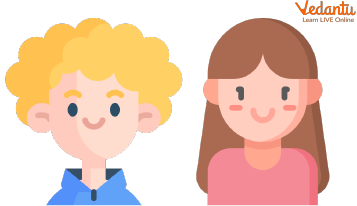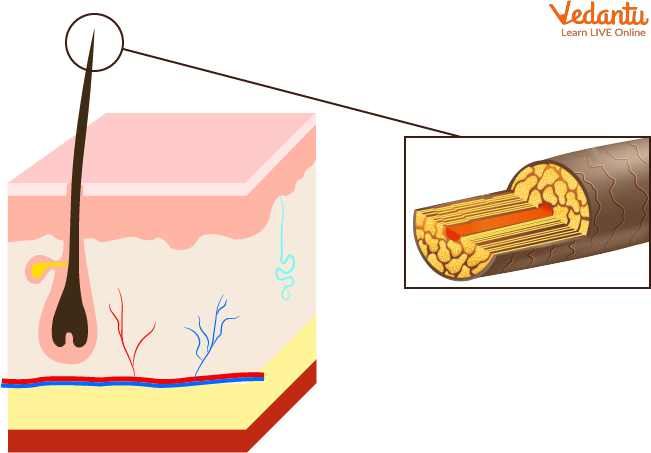




Why Is Understanding Hair Important for Students?
Curious about your natural crown? Here are some interesting hair-related facts and myths, including information on hair development, hair colour, and hairstyles. Since ancient times, new hairstyles have been created. The only human body part that miraculously grows, deteriorates, and then miraculously grows again is hair.

A Head Full of Hair
Although the pace of growth is roughly the same for all body hairs, the length of the growth stage varies. Hair on the forearm and eyelashes only lasts a month or less on average. The hair follicle rests for about three months before rousing itself for another growth stage. Head hair grows for two to six years before it withers at its root and falls out.
Hair Development and Anatomy
Around 50 to 80 hairs fall out each day. In winter, there is more shedding. Men's hair doesn't grow as quickly as women's hair. Between the ages of 15 and 30, hair growth is at its fastest, with a dramatic drop between 50 and 60. Hair grows roughly half an inch each month, or 1/72 of an inch, per day.
About 100,000 hair follicles, each capable of producing numerous hairs, are present on the normal head. On average, 85% of the head's hairs are growing at any given time. Capilli is the medical name for hair on the head. The cuticle (transparent, overlapping cells), cortex (source of strength, elasticity, and colour), and medulla make up the outermost, middle, and innermost layers of a single strand of hair, respectively.

Structure of Hair
Fun Facts about Hair Growth
Here is some very interesting hair information for you:
1. Facts About Hair Colour
The pigment melanin, which also colours skin and eyes, gives hair its colour.
The cortex, which is the middle layer of a hair, or the hair shaft, contains the colour.
The protein keratin makes up the majority of hair; darker hair chemically contains more carbon and less oxygen than lighter hair. Including the degree and timing of greying, hair colour is inherited.
Grey hair is not actually grey; rather, it is white or opaque due to a lack of pigment in the hair shaft.
Greying typically develops from the hairline to the back of the head.
Unpigmented grey hair typically has a coarser texture than coloured hair. With dyes and rinses, hair colour can be altered and improved, but coloured hair is typically 10% thinner than untreated hair.
2. Facts About Hairstyles
Depending on the angle and direction the hair shaft emerges from the follicle, hair can be straight, wavy, or curly.
Whorls, cowlicks, and the general tendency for hair to curl out on one side of the head and under on the other are all caused by the angle of the follicles, commonly known as the hair stream.
Hair can be rounded, oval, or flat in cross-section.
Straightening or other heat-based techniques can temporarily alter hair shape, but new growth will always retain its natural tendency.
Temperatures above 140°F can melt the hair shaft when trying to restructure hair, severely damaging it.
3. Facts About the Density of Hair
The typical number of hairs on a human scalp is 1,000 per square inch or about 1,20,000 total hairs.
The peak thickness is at age 20.
Blonde hair typically has the most hairs per head (140,000), followed by brown (110,000), black (108,000), and red (90,000).
Blonds have more hair than darker tones, but individual hairs are typically finer.
By the age of 60, 40% of women have suffered some form of hair loss, and 50% of all males are either bald or balding.
Male-pattern baldness is caused by a gene that, as men age, transforms the hormone testosterone into the new chemical dihydrotestosterone, which causes hair to become thinner and finer with each new hair generation until baldness develops.
Temporary hair loss can also be brought on by high fevers, tranquilisers, thyroid issues, and excessive stress.
Myths Regarding Hair
There are several myths regarding Hair, Here are a few of those and the true facts:
Summary
Hair has three parts: Cuticle, Cortex, and Medulla.
Hair is made up of a protein called Keratin.
Hair follicles’ shape decides whether the hair will grow straight or curly.
A typical scalp has 1,20,000 hairs.
FAQs on Must-Know Fun and Scientific Facts About Hair
1. Why is hair considered important for our body?
Hair serves multiple vital functions for our body. It acts as a natural protective layer for the scalp, shielding it from direct sunlight and regulating temperature. Beyond protection, the condition of our hair can often indicate our overall health, as vibrant hair usually means the body is receiving adequate nutrients. It also plays a significant role in a person's appearance and can reflect individual personality.
2. Is it unhealthy to wash hair every day?
Washing hair daily can sometimes disrupt the natural balance of the scalp's microbiome. This balance is crucial because it helps keep harmful bacteria and fungi in check. Over-washing might lead to issues like scalp inflammation, dandruff, or dryness. Experts often suggest washing hair two to three times a week using a mild shampoo and gently cleansing the scalp to avoid damage and maintain its natural oils.
3. What are some surprising facts about human hair?
Human hair holds many surprising facts. For instance, a single strand of hair is incredibly strong; it can support a weight of up to 100 grams. Hair is also the second fastest growing tissue in the body, right after bone marrow. Another fascinating fact is that humans are born with all their hair follicles, which means we don't develop new ones after birth.
4. What makes hair unique compared to other body parts?
Hair is unique because, unlike other body parts like skin or muscles, it's primarily made of a dead protein called keratin. This means hair itself has no nerves, blood vessels, or living cells once it emerges from the scalp. The living part of the hair is actually below the skin, inside the follicle. This structure allows hair to be strong and flexible without feeling pain when cut.
5. How fast does human hair typically grow?
On average, human hair grows about 0.5 inches (or 1.25 centimeters) per month, which adds up to about 6 inches (or 15 centimeters) per year. This growth rate can vary slightly depending on factors like genetics, age, and overall health. Each hair strand goes through a cycle of growth, rest, and shedding, and this continuous process ensures we always have hair on our heads.
6. Are there any common myths about hair that aren't true?
Yes, several common myths about hair are not true. For example, it's a myth that shaving makes hair grow back thicker or faster; it only appears that way because the cut end is blunt. Another myth is that plucking a grey hair will cause more to grow in its place; hair growth is determined by individual follicles, not by plucking. Understanding these facts helps in better hair care.
7. What are some effective tips for keeping hair healthy?
To keep hair healthy, focus on gentle care and good habits. Use a mild shampoo and conditioner suitable for your hair type. Avoid excessive heat styling, which can damage hair. A balanced diet rich in vitamins and proteins is crucial, as hair health is closely linked to overall nutrition. Regular trims can also help remove split ends and maintain hair vitality.
8. Why do some people have different hair colors or textures?
Hair color and texture are primarily determined by genetics. Hair color depends on the type and amount of melanin pigment produced in the hair follicles – eumelanin for black/brown and pheomelanin for red/yellow. Hair texture (straight, wavy, curly) is influenced by the shape of the hair follicle; round follicles produce straight hair, while oval follicles produce curlier hair.
9. How does hair protect us from the environment?
Hair serves as a crucial protective barrier against environmental elements. On the scalp, it provides insulation against both heat and cold, helping to regulate body temperature. It also acts as a physical shield against the sun's harmful UV radiation, reducing the risk of sunburn on the scalp. Additionally, eyelashes and nose hairs help filter out dust and small particles from entering the eyes and respiratory system.
10. Can our diet really affect the health and growth of our hair?
Absolutely, our diet significantly impacts hair health and growth. Hair is made of protein, so a diet rich in proteins (like lean meats, eggs, and legumes) is essential. Nutrients such as iron, zinc, biotin, and vitamins (especially A, C, and E) are also vital for strong, healthy hair follicles. A deficiency in these nutrients can lead to hair thinning, dullness, or even hair loss.









